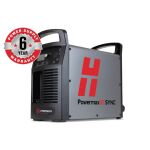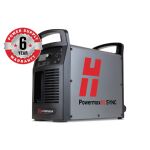Plasma Cutting Machines At Engweld
Plasma cutters are versatile machines used for plasma cutting. Plasma cutters produce a focused jet of hot plasma to slice through conductive materials with exceptional speed and precision. This makes them ideal for a wide range of applications, from fabrication shops and automotive repair to industrial construction and even DIY projects. They're suitable for cutting thin and thick materials alike, so long as the material conducts electricity.
Plasma cutters here at Engweld come in a variety of configurations to suit different needs. Our hand-held plasma cutters are perfect for quick cuts and on-site work, offering portability and ease of use. On the other hand, our stronger, computer-controlled (CNC) plasma cutting machines provide unparalleled precision and automation, allowing for intricate cuts and complex shapes on a larger scale. These machines often utilise high frequency transistor inverters to convert the mains supply voltage into a high-frequency current, maximising efficiency and control over the plasma arc.
Plasma cutting equipment excels at cutting a wide range of conductive materials, including:
- Steel (mild steel, thick steel plate)
- Stainless steel (generally found in CNC applications)
- Aluminium
- Copper (and other conductive metals)
Technical Comparison of Manual Plasma Cutters
This table compares the core technical specifications for a selection of professional and entry-level plasma cutting systems from ESAB, Lincoln, and Hypertherm. The focus is on Max Output Current, Recommended Cut Capacity, Input Power, and Unique Features.
| Model |
Max Output (Amps) |
Input Power (Volts / Phase) |
Recommended Cut (Mild Steel) |
Max Severance Cut |
Weight (Approx.) |
Key Technical Feature |
| ESAB Handy Plasma 35i |
35 A |
230V / 1 Ph |
6 mm |
12 mm |
13.5 kg |
Simple, intuitive LCD screen; auto air pressure adjust. |
| ESAB Handy Plasma 45i |
45 A |
230V / 1 Ph |
10 mm |
16 mm |
13.5 kg |
Higher single-phase output; auto air pressure adjust. |
| ESAB Cutmaster 30 |
30 A |
110V/230V / 1 Ph |
6 mm |
16 mm |
~10 kg |
Dual voltage (MV); high severance cut for low amps. |
| ESAB Cutmaster 50 |
50 A |
400V / 3 Ph |
16 mm |
32 mm |
16 kg |
High duty cycle (60% @ 50A); CNC-ready (CPC port). |
| ESAB Cutmaster 70 |
70 A |
400V / 3 Ph |
20 mm |
38 mm |
~19 kg |
High industrial output and heavy-duty capacity. |
| Lincoln Tomahawk 30K |
30 A |
230V / 1 Ph |
6 mm |
10 mm |
18 kg |
Built-in Air Compressor (ultimate portability). |
| Hypertherm Powermax 30 XP |
30 A |
120V/230V / 1 Ph |
10 mm |
16 mm |
9.7 kg |
Most portable (lightest); uses FineCut consumables for detail. |
| Hypertherm 30 AIR |
30 A |
120V/230V / 1 Ph |
10 mm |
16 mm |
~13.5 kg |
Built-in compressor model of the 30 XP. |
| Hypertherm Powermax 45 SYNC (230V) |
45 A |
230V / 1 Ph |
16 mm |
29 mm |
15 kg |
SmartSYNC single-piece cartridge; high 1-Ph recommended cut. |
| Hypertherm Powermax 45 SYNC (400V) |
45 A |
400V / 3 Ph |
16 mm |
29 mm |
15 kg |
Higher duty cycle at 45A compared to 230V model. |
| Hypertherm Powermax 65 SYNC (400V) |
65 A |
400V / 3 Ph |
20 mm |
32 mm |
20.6 kg |
Professional industrial standard; SmartSYNC; High 100% duty cycle (46A). |
Meet Our Experts
When your project demands more than just standard solutions, turn to the Fabex team at Engweld and Energas. This elite group of highly skilled engineers and fabricators specialises in tackling the most intricate and challenging welding and metalworking projects.
From unique material requirements to bespoke structural fabrications and precision-engineered components, the Fabex team combines deep technical knowledge with extensive hands-on experience. They're equipped to navigate the complexities that often deter others, delivering innovative, reliable, and high-quality results.
We understand that complex projects require meticulous planning and execution. The Fabex team works closely with clients, offering expert consultation and a collaborative approach to ensure your vision is realised with unparalleled precision and efficiency.
Plasma Cutter Service & Repair
To further complement our expert fabex sales team, we have a expert team of 8 repair & service engineers to support all our customer base from small to large customers to repair, service and calibrate your plasma cutter, to get you back fully operating and cutting.
Plasma Cutter Warranty
Your investment in your next plasma cutter needs to be protected for the full length of it's lifespan. You need to make sure have the right warranty that works for you. See our warranty information from a wide range of plasma cutting manufacturers including Hypertherm, ESAB & Lincoln Electric.











































